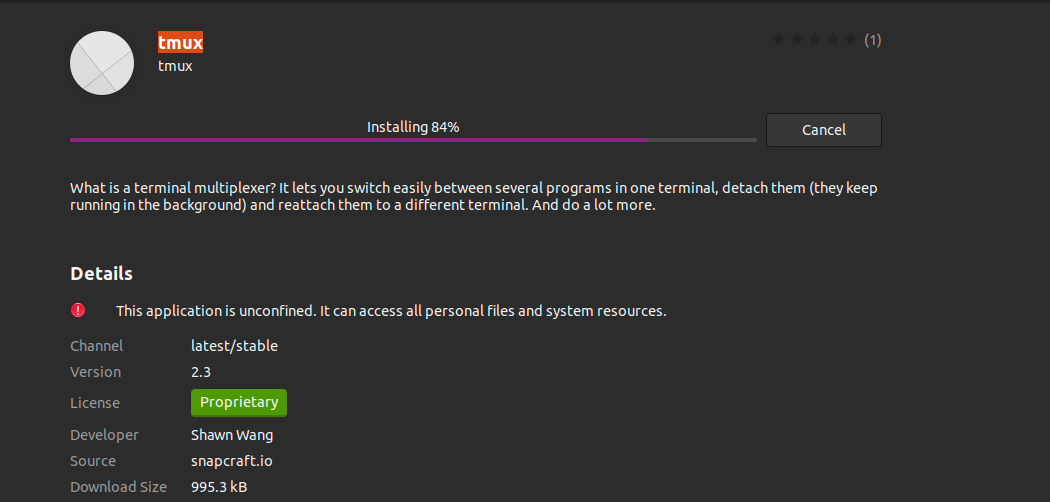In general, when you close an SSH connection, the corresponding remote terminal sessions are also closed. Here comes the Tmux for help as it preserves those sessions when the SSH connection is terminated.
After installing Tmux, you will not find any icon associated with it. It will not appear as a separate application; instead, we will have to invoke it from the Gnome Terminal itself. We will later see how to do this.
Note: In this ‘HowTo’ we have used the ‘Ctrl+b’ as the prefix; if you configured some other prefix, then replace the command with yours’ prefix.
What will we cover?
This guide will explore how we can install Tmux and, more specifically, “How to use Tmux mouse mode”. We will use Ubuntu 20.04 as the base system for this guide. Let us first start with installing Tmux.
Prerequisites
1. Tmux should be installed on your system.
2. Internet connectivity and user account with ‘sudo’ privileges.
Installing Tmux on Ubuntu 20.04
Major operating systems like Linux, MacOS and Windows Subsystem for Linux (WSL) provide Tmux software packages from their official repository. So to install Tmux on Ubuntu 20.04, we can simply use the package manager or Software center as described below:
1. To install Tmux using package manager, simply run the command:
2. To install Tmux using the software center, open the software center, search for Tmux and click install.
Launching Tmux
Once the Tmux is installed, we will have to use the Gnome terminal to invoke it. One may encounter the following error when trying to run the ‘tmux’ command:
To overcome this error, type “export TERM=xterm” on the terminal and hit enter. Now again, run the ‘tmux’ command, and this time the error should not appear.
Another way is to use the ‘XTERM’ terminal and launch the Tmux from here. This worked on our Ubuntu 20.04 system.
How to Use Tmux
We can use three ways to send commands to a Tmux terminal:
Using the Prefix keys: Tmux uses a combination of keys called prefix key, which is by default ‘CTRL+b’. This prefix is followed by one or two more keys which Tmux will interpret for a particular operation. For example, we can detach from a session using [Prefix+d].
Using the command mode: To send the commands directly to the Tmux terminal, we need to enter the command mode by pressing the prefix keys followed by a colon (:). A command prompt will open up at the bottom of the terminal, where we can enter the Tmux commands.
Using the command line: Tmux commands can also be used from the non-Tmux terminal or shell prompt. These commands are preceded by the ‘tmux’ keyword. We have illustrated this method in the below section.
Using Mouse Mode For Tmux >= 2.1
When we start using Tmux (of course, as a novice), we feel how nice it would be to scroll or select Tmux windows with a mouse. Surely, we can do that in Tmux by customizing the tmux.conf file. This is where Tmux mouse mode comes into play. Let see the mouse mode in action:
Enabling the mouse mode
We need to first enable the mouse mode. Open the tmux.conf file and put the following line inside it:
Now reload the ‘tmux.conf’ file:
Note: Every time we make changes to tmux.conf file, source, or reload the tmux.conf file to make the changes work.
After reloading the tmux.conf file, we can control the pane selection, pane resizing and window selection operation with the Mouse itself.
Using Tmux Mouse Mode For Tmux < 2.1
In Tmux version < 2.1 we can put the following lines to make the mouse manage the pane selection, pane resizing and window selection:
set -g mouse-select-pane on
set -g mouse-resize-pane on
set -g mouse-select-window on
If you want to make yourself comfortable with the keybindings of Tmux operations, we suggest you disable the mouse options by simply setting the above option to ‘off’ or directly disabling the mouse mode by:
In this way, we can also avoid doing wrong things while selecting Tmux’s windows/panes with a mouse.
Mouse action in Tmux
We can also select a word and a line in Tmux. E.g. to select a word, hold the right button and double click the left button. Similarly, hold the right button and triple click the left button to select a line. You can now also use the arrow keys to select multiple lines.
Conclusion
In this guide, we have learned about the installation of Tmux, its basics and more specifically, “How to use Tmux mouse mode”. Although we can use Tmux mouse mode, it is generally a good practice to use Keyboard. This is because as the number of applications increases, it becomes very distractive to use a mouse for switching between panes and windows running different applications. A more detailed explanation of various Tmux operations can be found on the Tmux Man pages or on the Github page of Tmux.



